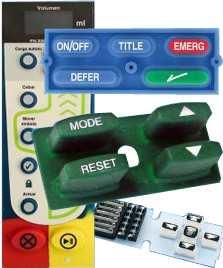
Rubber keypads are used in a wide variety of consumer and commercial applications. Consisting of a rubber pad with many individual switches or keys, they function as device interfaces. You can control a device by pressing the buttons on its rubber keypad. When researching rubber keypads, however, you may encounter some unfamiliar terms.
Actuation Force
Also known as activation point, actuation force is the amount of force that must be exerted on a rubber keypad to register a keypress. It’s typically measured in grams. The higher a rubber keypad’s actuation force, the harder you’ll have to press the keys when using it.
Backlighting
Backlighting is an illumination feature that involves the use of small bulbs or diodes in the rear of a rubber keypad. It improves visibility in nighttime and low-light conditions while also enhancing the keypad’s overall aesthetics.
IP Rating
IP rating refers to “Ingress Protection.” It represents the degree to which a device, such as a rubber keypad, is protected from dust and moisture. The higher the IP rating, the greater the protection.
Key Travel
Key travel is the vertical distance the keys on a rubber keypad must travel to trigger a keypress. Rubber keypads are essentially a collection of many switches. Each switch features two conductive pieces that are separated by default. Pressing a key will force the top conductive piece into the bottom conductive piece, thereby completing the circuit and triggering a keypress. Key travel is a measurement of how far you must press a key to complete this circuit.
Laser Etching
Laser etching is a manufacturing process that involves the use of a high-powered laser to melt the surface of an object, such as a rubber keypad. It’s commonly used to remove paint from the top layer of rubber keypads. By removing some of the paint, the rubber keypad will have a transparent top layer that allows the light from backlighting to shine through.
Silicone Rubber
Not all rubber keypads are made of plain rubber. In recent years, silicone rubber has become a popular material used in the construction of rubber keypads. As an elastomeric material, it offers a superior level of flexibility. Silicone rubber is also resistant to heat, cold and moisture.
Tactile Feedback
Tactile feedback is a sensation or response that a rubber keypad creates when you press a key. Most rubber keypads are designed with some degree of tactile feedback. When you press and release your finger from a key, for instance, you may feel the key pop back up. This is a form of tactile feedback.
